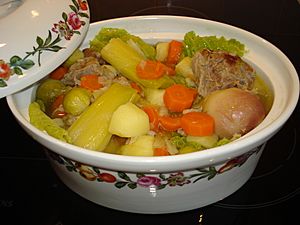Hochepot facts for kids
The hochepot (pronounced "osh-po") is a yummy stew that people really enjoy in the Nord-Pas-de-Calais area of France, and also in Flanders and Hainaut in Belgium. This dish is super old, going all the way back to the Middle Ages! The very first recipes we know about were written in a cooking book called the Manuscript of Sion, which is one of the oldest French cooking guides from around the 1200s. Even though its name sounds a bit like the Dutch dish hutspot, they are actually quite different. Dutch hutspot is made with mashed potatoes, while hochepot has whole vegetables.
Contents
What is Hochepot?
Hochepot is a traditional stew from Flanders. It's usually made with different kinds of meat like oxtail, lamb shoulder, and salted bacon. What makes it special is that the vegetables, such as carrots, parsnips, onions, leeks, celery, and potatoes, are cooked and served whole, not mashed up.
In the past, hochepot was often cooked in a clay pot with meat, chestnuts, and turnips. Today, people make it with various meats like beef ribs, lamb, veal, salted pork, and even sausages. These ingredients simmer slowly in a pot with winter vegetables such as carrots, parsnips, onions, leeks, celery, and potatoes, along with different herbs.
Where Does Hochepot Come From?
Hochepot is an old recipe from northern France and is a very important dish in Flanders and the province of Hainaut. The word "hochepot" comes from an old French word, "hottison," which means "to shake." The name also used to describe a chicken dish cooked with vegetables and pieces of beef.
Hochepot Through History
The oldest cooking guide written in French is called the Manuscript of Sion. It was written around the end of the 1200s and was found in a library in Switzerland. This old book has a recipe that explains how to cook boar and deer meat. It says the meat should be "boiled for a long time, larded from within, then cooked in new water with mace and a lot of wine. Add a cameline sauce."
While this old recipe doesn't mention vegetables, it does talk about how to prepare salted meat. It advises to "soak it, then wash it very well. Throw out the first broth. Wash with clean water. Let cool. Then cut into thin slices. Bring to a boil with half water and half white wine. Then peel chestnuts cooked on the coals. Place everything on a plate. Serve the game meat with the broth. Eat with some mustard."
This way of cooking is very similar to a hochepot recipe found in a manuscript from the Ghent University Library, which dates back to the late 1400s or early 1500s. This recipe, called "Om hutspot te redenen van een hert" (which means "To prepare hutspot from a deer"), sounds like a medieval stew. It includes venison (deer meat), onions, and red wine. It also suggests using verjuice (a sour grape juice), butter, sugar, nutmeg, and cardamom. Back then, hochepot was simply a type of meat cooked in a liquid. This is the main connection between the old medieval hochepots and the Flemish hochepots we know today.
Another old cooking book, Le Viandier de Taillevent, from the 1300s, has only one hochepot recipe, which is made with poultry. The oldest version of a hochepot recipe is still the one in the Manuscript of Sion. It describes a stew with "pieces of poultry fried with bacon. It is cooked then in a broth and thickened with some liver and toast. It is spiced with cinnamon and maniguette and then mixed with some verjuice to give it a clear appearance."
The recipe for hochepot has changed a lot over time. The medieval hochepots had many different recipes, so it's hard to give one exact definition for them. However, we know they are the ancestors of the hochepot we enjoy today!
What to Drink with Hochepot?
In the Nord-Pas-de-Calais region, people traditionally enjoy hochepot with a light beer or a fresh, young white wine.
See also
 In Spanish: Hochepot para niños
In Spanish: Hochepot para niños


